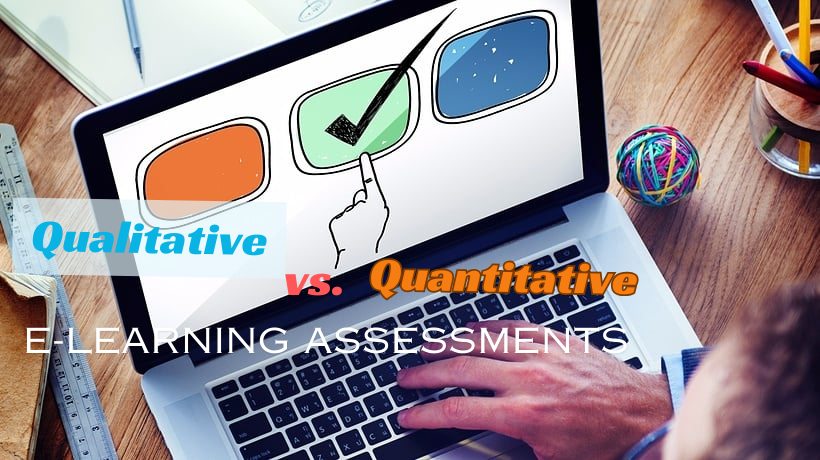Qualitative Vs Quantitative E-Learning Assessments
Assessing the abilities of learners is part of the training process, so assessments are important elements in any e-learning course. There are many different types of assessments you can use, with each falling into either the qualitative or quantitative category.
So, what are qualitative assessments and how do they differ from quantitative assessments (apart from the very small difference in spelling)? Does it matter which type you use in your e-learning course and how do you decide?
Quantitative E-Learning Assessments Explained
Quantitative refers to any type of assessment that can be measured with a number. It is an assessment that can be quantified with a definitive result.
The most obvious example is a quiz where the questions are structured so there is only one correct answer. For example, a quiz with multiple choice questions. At the end of the quiz, the learner will get a score. That score is a quantitative assessment of the learner’s capabilities at that point in time.
Other examples of quantitative assessments in e-learning and training in general include:
- Measurable KPIs – sales figures, accident records, and customer satisfaction scores are all examples.
- Completion rates – how many people started the course and the number that completed it.
- Satisfaction scores and ratings – learner evaluations of the course.
Benefits of Quantitative Assessments
The benefits of quantitative assessments include:
- Easy to collect the information in most cases.
- The assessment is objective rather than subjective.
- The results are usually very reliable.
- Quantitative assessments are repeatable and largely consistent, regardless of potentially influencing factors such as location or group.
- Quantitative assessments can be applied to large groups of learners at the same time.
- It is easy to compare results from quantitative assessments.
- Quantitative assessments can be used to make predictions.
Qualitative E-Learning Assessments Explained
Qualitative assessments are descriptive rather than based on a numerical value. They are also often observational where the assessment is not just on knowledge, but the ability to apply that knowledge in a relevant situation.
A scenario element in an e-learning course is a good example, especially where there are no clear right or wrong decisions. A qualitative assessment like this will show the learner’s ability to deal with the situation presented in the scenario.
Other examples of qualitative assessments include:
- Observing behaviour change, often on the job with feedback from managers or supervisors.
- Learner feedback questionnaires where learners are asked to give opinions rather than just ratings.
- Projects where learners have to apply the learning over time.
Benefits of Qualitative Assessments
The benefits of qualitative assessments include:
- Qualitative assessments are more detailed and nuanced.
- Qualitative assessments are also more contextual where you get an understanding of the ability of the learner under real-world conditions.
- Qualitative assessments let you dive deeper into a learner’s understanding of the topic and their ability to apply that understanding.
The Need for Both Qualitative and Quantitative Assessments
In most e-learning courses and training topics, it is beneficial to have both qualitative and quantitative assessment elements.
For example, it is important to know the learner has understood the information covered in the course and has acquired the necessary knowledge. You can do this through a quiz at the end of the course, i.e., a quantitative assessment.
Achieving the objectives that you put in place for the training course also often involves changing behaviours. In other words, you want the learner to understand the information and then put it to use in their day-to-day work. Observing behaviour change in the weeks and months after the course is a qualitative method of making this assessment.
The Learning to Drive Example
Learning to drive is a good example of the need for both qualitative and quantitative assessments. The starting point when learning to drive is often learning road laws and the theory of driving safely. This can be done in a classroom setting with an exam at the end. The exam is a quantitative assessment.
The result of this exam will demonstrate the learner’s knowledge of road laws and driving safely, so it is a necessary component. However, it is in no way an assessment of the learner’s ability to effectively, safely, and legally drive a car. That requires a qualitative assessment, i.e., a test where the learner is observed as they drive on real roads.
Both the quantitative component and the qualitative element are necessary in this example, and they are also necessary for most corporate training topics.
Applying Qualitative and Quantitative Assessments in Your E-Learning Courses
You can include both quantitative and qualitative assessments in the design of your e-learning courses. For example, including a scenario as well as a quiz. Other elements are also likely to be necessary, such as learner feedback questionnaires, KPI analysis, and getting feedback from managers.
Conducting both qualitative and quantitative assessments will give you a more complete understanding of the success of your e-learning course and whether your objectives have been achieved.
